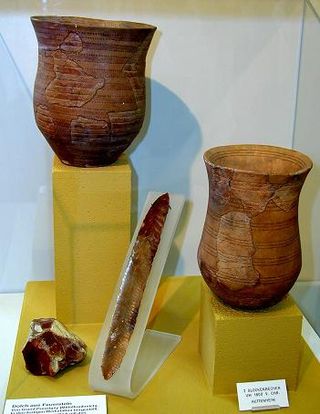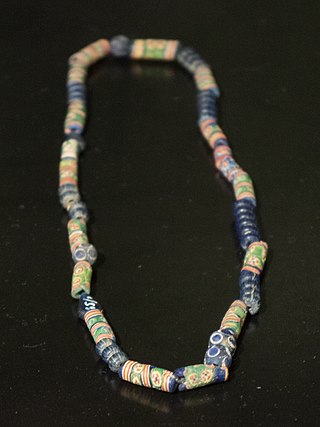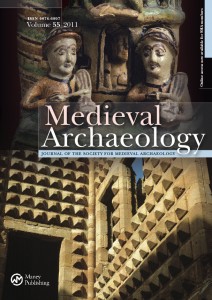Related Research Articles

The Anglo-Saxons were a cultural group that inhabited much of what is now England in the Early Middle Ages, and spoke Old English. They traced their origins to Germanic settlers who came to Britain from mainland Europe in the 5th century. Although the details are not clear, their cultural identity developed out of the interaction of these settlers with the pre-existing Romano-British culture. Over time, most of the people of what is now southern, central, northern and eastern England came to identify as Anglo-Saxon and speak Old English. Danish and Norman invasions later changed the situation significantly, but their language and political structures are the direct predecessors of the medieval Kingdom of England, and the Middle English language. Although the modern English language owes somewhat less than 26% of its words to Old English, this includes the vast majority of words used in everyday speech.

A scriptorium was a writing room in medieval European monasteries for the copying and illuminating of manuscripts by scribes.

Glastonbury Abbey was a monastery in Glastonbury, Somerset, England. Its ruins, a grade I listed building and scheduled ancient monument, are open as a visitor attraction.

The early medieval history of Ireland, often referred to as Early Christian Ireland, spans the 5th to 8th centuries, from the gradual emergence out of the protohistoric period to the beginning of the Viking Age. The period includes the Hiberno-Scottish mission of Christianised Ireland to regions of pagan Great Britain and the spread of Irish cultural influence to Continental Europe.

Prehistoric archaeology is a subfield of archaeology, which deals specifically with artefacts, civilisations and other materials from societies that existed before any form of writing system or historical record. Often the field focuses on ages such as the Stone Age, Bronze Age and Iron Age, although it also encompasses periods such as the Neolithic. The study of prehistoric archaeology reflects the cultural concerns of modern society by showing interpretations of time between economic growth and political stability. It is related to other disciplines such as geology, biology, anthropology, historiography and palaeontology, although there are noticeable differences between the subjects they all broadly study to understand; the past, either organic or inorganic or the lives of humans. Prehistoric archaeology is also sometimes termed as anthropological archaeology because of its indirect traces with complex patterns.

Culture-historical archaeology is an archaeological theory that emphasises defining historical societies into distinct ethnic and cultural groupings according to their material culture.

The Archaeological Museum of Asturias is housed in the 16th century Benedictine monastery of Saint Vicente in Oviedo, Asturias, Spain. Its findings include collections of the Asturian Neolithic, Megalithic, Bronze Age, Iron Age, Astur hill fort culture, Roman period, and of the Gothic, Pre-Romanesque and Romanesque periods of the Kingdom of Asturias. The museum also includes sections of Asturian Ethnography, Heraldry, Medieval and Modern Epigraphy, Spanish Numismatics, a European Medal Section, and Armor.

The Przeworsk culture was an Iron Age material culture in the region of what is now Poland, that dates from the 3rd century BC to the 5th century AD. It takes its name from the town Przeworsk, near the village where the first artifacts were identified.
Archaeological theory refers to the various intellectual frameworks through which archaeologists interpret archaeological data. Archaeological theory functions as the application of philosophy of science to archaeology, and is occasionally referred to as philosophy of archaeology. There is no one singular theory of archaeology, but many, with different archaeologists believing that information should be interpreted in different ways. Throughout the history of the discipline, various trends of support for certain archaeological theories have emerged, peaked, and in some cases died out. Different archaeological theories differ on what the goals of the discipline are and how they can be achieved.

Sub-Roman Britain is the period of late antiquity in Great Britain between the end of Roman rule and the Anglo-Saxon settlement. The term was originally used to describe archaeological remains found in 5th- and 6th-century AD sites that hinted at the decay of locally made wares from a previous higher standard under the Roman Empire. It is now used to describe the period that commenced with the recall of Roman troops to Gaul by Constantine III in 407 and to have concluded with the Battle of Deorham in 577.

Farfa Abbey is a territorial abbey in northern Lazio, Central Italy. In the Middle Ages, it was one of the richest and most famous abbeys in Italy. It belongs to the Benedictine Order and is located about 60 km (37 mi) from Rome, in the commune of Fara Sabina, of which it is also a hamlet.
The following outline is provided as an overview of and topical guide to archaeology:

Kells is a village near Ballymena in County Antrim, Northern Ireland. The village of Connor lies close by, and the two are often spoken of collectively. Kells and Connor had a population of 2,053 people in the 2011 Census.
Alex Woolf is a British medieval historian and academic. He specialises in the history of Britain and Ireland and to a lesser extent Scandinavia in the Early Middle Ages, with a particular emphasis on interaction and comparison across traditional ethnic boundaries. He is a senior lecturer at the University of St Andrews.

Scotland was divided into a series of kingdoms in the early Middle Ages, i.e. between the end of Roman authority in southern and central Britain from around 400 AD and the rise of the kingdom of Alba in 900 AD. Of these, the four most important to emerge were the Picts, the Gaels of Dál Riata, the Britons of Alt Clut, and the Anglian kingdom of Bernicia. After the arrival of the Vikings in the late 8th century, Scandinavian rulers and colonies were established on the islands and along parts of the coasts. In the 9th century, the House of Alpin combined the lands of the Scots and Picts to form a single kingdom which constituted the basis of the Kingdom of Scotland.
Roberta Lynn Gilchrist, FSA, FBA is a Canadian-born archaeologist and academic specialising in the medieval period, whose career has been spent in the United Kingdom. She is Professor of Archaeology and Dean of Research at the University of Reading.
Andrew Reynolds is an English archaeologist specialising in the study of medieval Britain. He is a lecturer at the Institute of Archaeology, University College London. Reynolds worked as a field archaeologist from 1985 to 1990 before going on to gain a BA in Medieval Archaeology and a PhD from University College London.

The Komani-Kruja culture is an archaeological culture attested from late antiquity to the Middle Ages in central and northern Albania, southern Montenegro and similar sites in the western parts of North Macedonia. It consists of settlements usually built below hillforts along the Lezhë (Praevalitana)-Dardania and Via Egnatia road networks which connected the Adriatic coastline with the central Balkan Roman provinces. Its type site is Komani and its fort on the nearby Dalmace hill in the Drin river valley. Kruja and Lezha represent significant sites of the culture. The population of Komani-Kruja represents a local, western Balkan people which was linked to the Roman Justinianic military system of forts. The development of Komani-Kruja is significant for the study of the transition between the classical antiquity population of Albania to the medieval Albanians who were attested in historical records in the 11th century.

Ralph Merrifield was an English museum curator and archaeologist. Described as "the father of London's modern archaeology", Merrifield was a specialist in the archaeology of both Roman London and magical practices, publishing six books on these subjects over the course of his life.

Medieval Archaeology is an annual peer-reviewed academic journal covering the archaeology of the medieval period, especially in the United Kingdom and Ireland. It was established in 1957 by the Society for Medieval Archaeology and is published on their behalf by Taylor & Francis. The editor-in-chief is Aleks McClain.
References
- ↑ Gilchrist, Roberta 1994. 'Chapter 1. The Handmaid's Tale'. In Gilchrist, R. Gender and Material Culture. London: Routledge, pp. 1-21.
- ↑ Gilchrist, Roberta and Reynolds, Andrew, eds. (2009) Reflections: 50 Years of Medieval Archaeology, 1957-2007. Society for Medieval Archaeology Monographs, 30. Maney, Leeds
- ↑ Gerrard, Chris M. (2007). "Retrospect and Prospect: 50 years of Medieval Archaeology", webpage: MA-uk.
- ↑ Gerrard, Chris M. (2003). Medieval Archaeology. Understanding traditions and contemporary approaches. London: Routledge.
- ↑ Audouze, Françoise; Leroi-Gourhan, André (1981). "France: A continental insularity". World Archaeology. 13 (2): 170–189. doi:10.1080/00438243.1981.9979824. ISSN 0043-8243.
- ↑ Aston, Mick (2000) Monasteries in the Landscape. Revised Edition. The History Press
- ↑ Gilchrist, Roberta (2014-10-21). "Monastic and Church Archaeology". Annual Review of Anthropology. 43: 235–250. doi: 10.1146/annurev-anthro-102313-025845 .